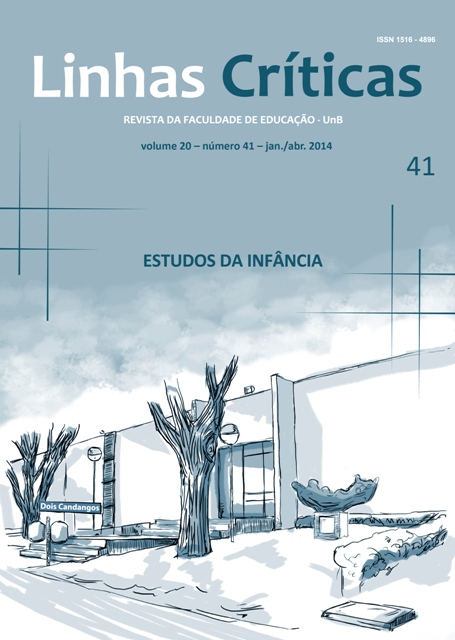Visibility of children and childhood
DOI:
https://doi.org/10.26512/lc.v20i41.4250Keywords:
Children, Childhood, Visibility, Protection/participationAbstract
This article discusses the different meanings of ‘child’, ‘children’ or ‘childhood’ within different contexts, in order to analyze the relevance of what may be called visibility ”“ or invisibility ”“ of childhood. For the discussion, auxiliary concepts, such as private/public, and dichotomies, such as protection/participation, are used. The analysis shows that the idea of visibility or invisibility of children and childhood is ambiguous and its imports vary historically. The paper also presents an assesment of the production of statistics on children and childhood, and, in the same line, examines children’s place in social policy.
Downloads
References
ARIÈS, Philippe. Centuries of Childhood: a social history of family life. New York: Vintage Books, 1962.
ARIÈS, Philippe. Barndommens historie. Copenhagen: Nyt Nordisk Forlag, 1982.
ARIÈS, Philippe. Saint-Pierre oder die Süsse des Lebens. Versuche der Erinnerung. Berlin: Verlag Klaus Wagenbach, 1994.
BELKIN, Lisa. Your Kids Are Their Problem. New York Times Magazine, July 23, 2000, p. 30ff.
BENDIX, Reinhard. Nation-building and citizenship: Studies of our changing social order. Berkeley: University of California Press, 1977.
BRUNNER, Otto. Vom ‘ganzen Haus’ zur ‘Familie’ im 17. Jahrhundert. In: ROSENBAUM, Heidi (Ed.) Seminar: Familie und Gesellschaftsstruktur. Suhrkamp: Frankfurt am Main, 1980, p. 83-92.
DAVIS, Kingsley. ‘The sociology of parent-youth conflict’. American Sociological Review, v. 5, n. 4, 1940, p. 523-35.
DEMAUSE, Lloyd. The Evolution of Childhood’. In: DEMAUSE, Lloyd. (Ed.) The history of childhood. New York: The Psychohistory Press, 1974. p. 1-73.
HENGST, Heinz. The liquidation of childhood: an objective tendency. International Journal of Sociology, M.E. Sharpe, v. 17, n. 3, p. 58-80, fall. 1987.
HILLMAN, Meyer; ADAMS, John; WHITELEGG, John. One false move... a study of children’s independent mobility. London: Policy Studies Institute, 1990.
JAMES, Phyllis Dorothy. The children of men. London: Faber & Faber,1992.
JAMES, Allison; JENKS, Chris; PROUT, Alan. Theorizing Childhood. Cambridge: Polity Press, 1998.
KAUFMANN, Franz-Xaver. Schrumpfende Gesellschaft: Vom Bevölkerungsrückgang und seinen Folgen. Frankfurt a.M: Suhrkamp, 2005.
KEY, Ellen. Barnets århundrade: studie. Stockholm: Bonniers førlag, 1900.
KUZNETS, Simon. Economic development, the Family, and Income Distribution: selected essays. Cambridge: Cambridge University Press, 1989.
LAKOFF, George. Moral politics: how liberals and conservatives think. Chicago and London: The University of Chicago Press, 2002.
LASCH, Christopher. Haven in a heartless world: the family besieged. New York: Basic Books, 1977.
MARX, Karl. Critique of the Gotha-Programme: Marx/Engels selected works. v. 3. Moscow: Progress Publishers, 1970 [1875].
O’BRIEN, Margaret; JONES, Deborah; SLOAN, David; RUSTIN, Michael. Children’s Independent Spatial Mobility in the Urban Realm. Childhood, Norway, v. 7, n. 3, p. 257-77, Aug. 2000.
O’NEILL, John. The missing child in liberal theory. Toronto: Toronto University Press, 1994.
POSTMAN, Neil. The disappearance of childhood. London: W.H. Allen, 1983.
QVORTRUP, Jens. Are Children Human Beings or Human Becomings? A Critical Assessment of Outcome Thinking. Rivista Internazionale di Scienze Sociali, Università Cattolica del Sacro Cuore, v. CXVII, n. 3-4, p. 631-653, 2009.
SARTRE, Jean-Paul. Search for a method. Alfred A. New York: Knopf, 1967.
SURANSKY, Valerie P. The erosion of childhood. Chicago: The University of Chicago Press, 1982.
THORNE, Barrie. Re-Visioning Women and Social Change: Where Are The Children? Gender and Society, Sage Publications, v. 1, n. 1, p. 85-109, Mar. 1987.
UNICEF. A League Table of Child Maltreatment Deaths in Rich Countries. Innocenti Report Card, Issue n. 5. Florence: Unicef, 2003.
ZELIZER, Viviana A. Pricing the priceless child. The changing social value of children. New York: Basic Books, 1985.
Downloads
Published
How to Cite
Issue
Section
License
Copyright (c) 2016 Linhas Críticas

This work is licensed under a Creative Commons Attribution 4.0 International License.
Authors who publish in this journal agree to the following terms:
-Authors maintains the copyright and grants the journal the right of first publication, the work being simultaneously licensed under the Creative Commons Attribution License which allows the sharing of the work with recognition of the authorship of the work and initial publication in this journal.
- Authors are authorized to enter into additional contracts separately, for non-exclusive distribution of the version of the work published in this journal (eg publish in institutional repository or as a book chapter), with acknowledgment of authorship and initial publication in this journal.
-Authorers are allowed and encouraged to publish and distribute their work online (eg in institutional repositories or on their personal page) at any point before or during the editorial process, as this can generate productive changes as well as increase the impact and the citation of published work (See The Effect of Free Access).



